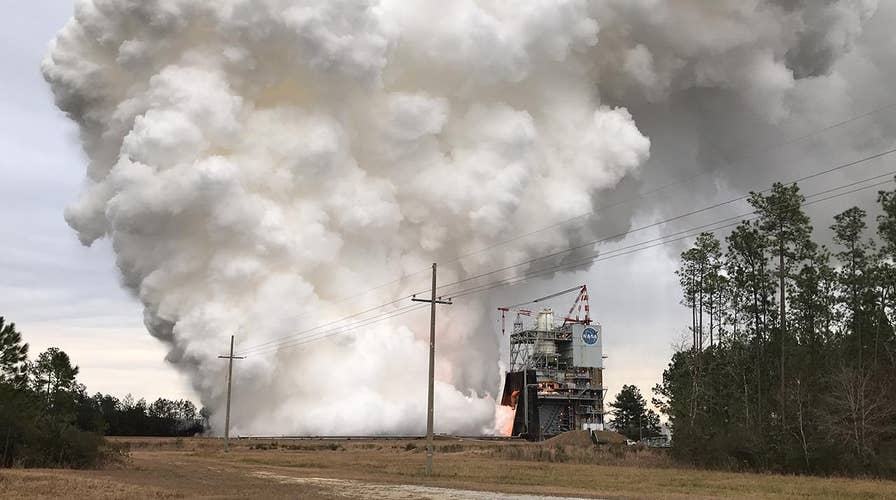NASA test fires engine with 3-D printed part
NASA tested its powerful RS-25 rocket engine with a 3-D printed part at the Stennis Space Center in Mississippi on January 16. The move is part of a cost saving measure for future deep space missions.
NASA tested its powerful RS-25 engine for the first time in 2018 this week with a new part that was made in an unconventional way. The complex machine has over 7,500 parts but one important component was made using a 3D printer.
The engine test lasted just over six minutes and created a loud roar with huge plumes of water vapor in the cold Mississippi sky at the NASA Stennis Space Center on Tuesday.
Aerojet Rocketdyne engineers say this is the second time they have tested the 3D-printed pogo accumulator, which is ‘printed’ using a laser and metal powder at a facility in Canoga Park, Calif. The machine constructs the part in two halves within weeks compared to construction by hand, which could take years according to Alan Fung, one of the lead mechanical design engineers on the project. He says the part acts as a ‘shock absorber’ giving astronauts a smoother ride while blasting off to space.

An Aerojet Rocketdyne technician inspects a 3-D printed pogo accumulator at the manufacturer's facility located on the grounds of the NASA Stennis Space Center in Mississippi. The new component is part of a push by NASA to reduce overall costs of future deep space missions. (Aerojet Rocketdyne)
“As you’re driving along a cobble stone road you have dampeners in your car that make it a nice smooth ride and that’s what were doing for astronauts,” Fung said, standing in front of the massive engine at Aerojet Rocketdyne’s facility in Mississippi.
HOW JOHN YOUNG SMUGGLED A CORNED-BEEF SANDWICH INTO SPACE
“When the astronauts are riding up into space they’ll feel this vibration that kind of feels like jumping on a pogo stick. That’s where the name comes from. While the astronauts are feeling that, it’s causing a lot of problems for the engine so we don’t want that effect,” he said.
Fung says over the next year, engineers plan to add nearly 40 additional 3-D printed parts to the RS-25 engine. NASA has started ramping up testing at the rocket testing facility in the Magnolia State.
“This series that we’re working on right now [includes] new hardware that will be developed, [tested] and certified,” Ronnie Rigney the RS-25 test project manager at Stennis Space Center said. “Once the designs are accepted, they will be manufactured regularly for the future engines that will be built on this program.”
Rigney noted that a flight controller, which helps the engine communicate with the entire rocket, was also tested on Tuesday.
HOW SPACE CAN CHANGE THE HUMAN BODY
The plan aims to reduce waste and costs for the Space Launch System (SLS), which is NASA’s next generation rocket and heavy-lift vehicle. Four RS-25 engines along with two solid rocket boosters will propel the massive spacecraft beyond Earth’s atmosphere. The SLS program will also use repurposed RS-25 engines from the Space Shuttle era. Unlike the space shuttle, the SLS rocket is expendable.
“When we selected RS-25 for the SLS program we had that tremendous cost avoidance upfront,” said Steve Wofford who is the manger for the SLS’s liquid engines program. “For new RS-25 engines we’re embarking on a program now to re-design those engines to make them 30 percent more affordable.”
NASA claims the SLS will be the most powerful rocket ever constructed by mankind and could put humans on the surface of Mars by the 2030’s, but the price tag may be too much to bear. Experts estimate a trip to Mars could cost anywhere from $100 billion to $1 trillion. NASA’s associate administrator for human exploration William Gerstenmaier, has previously said the space agency may not have the funds to send humans to the Red Planet. He also says the lack of air on Mars is an obstacle for landing a manned crew on the surface since air helps slow a spacecraft’s descent.
“NASA is working strategically within the year-to-year budgeting process to plan for future needs, including deep space missions to the Moon, Mars and beyond, and undertakes our challenging work within existing funding,” Cheryl Warner, a spokesperson for NASA said in a statement to Fox News. “We are currently waiting for more information on the fiscal year 2019 budget, which we expect next month.”
NASA is planning to test fire four RS-25 engines at once in early 2019.





















